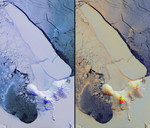|
TERMS OF USE:
This free image can only be used for non-commercial, personal
website use only. THIS IMAGE CANNOT BE
used in galleries, downloaded to your computer, posted on sites for
others to use, manipulated, downsized, or upsized. If you are confused about the
terms of use or have any questions then contact us before using the image.
Free Picture: Breakup of the World's Largest Iceberg

|
Description
Iceberg B-15A was the largest iceberg in the world (measuring about 11,000 square kilometers) when it broke away from Western Antarctica's Ross Ice Shelf in March 2000. It held that distinction for over three years until splitting into two pieces in early October, 2003. The Multi-angle Imaging SpectroRadiometer (MISR) acquired these views of the new iceberg B-15J (resting against Ross Island) and B-15A (now free to drift into the Southern Ocean) on October 26. Several massive icebergs (including B-15A) had migrated during 2000 and 2001 and ground against Ross Island, forming a barrier that influenced wind and current patterns and altered the regional ecology. The two images provide information on both the spectral and angular reflectance properties of ice types in the region. The left-hand panel is a false-color view from MISR's vertical-viewing (nadir) camera in which near-infrared, red and blue spectral data are displayed as red, green and blue, respectively. Because of the tendency of water to absorb near-infrared wavelengths, some ice types exhibit an especially bright blue hue in this display. The right-hand panel is a multi-angular composite from three MISR cameras, in which color acts as a proxy for angular reflectance variations related to texture. Here, data from the red-band of MISR's 60° forward-viewing, nadir, and 60° backward-viewing cameras are displayed as red, green and blue, respectively. In the southern latitudes, MISR's backward-pointing cameras receive a stronger signal from surfaces that predominantly forward scatter sunlight (these tend to be smooth surfaces), and MISR's forward-pointing cameras receive a stronger signal from surfaces that predominantly backscatter sunlight (these tend to be rougher surfaces). Thus, the colors in this representation highlight textural properties of elements within the scene, with blue tones indicating smoother surfaces and red/orange hues indicating rougher surfaces.
Keywords
antarctica, earth science, iceberg, iceberg b 15a, iceberg b 15j, iceberg b15a, iceberg b15j, icebergs, jpl, nasa, ross ice shelf, ross island, breakup of the worlds largest iceberg, free photography, free photo, free photos, free picture, free pictures, free image, free images
|
Similar Free earth science Pictures
|
|
|
|